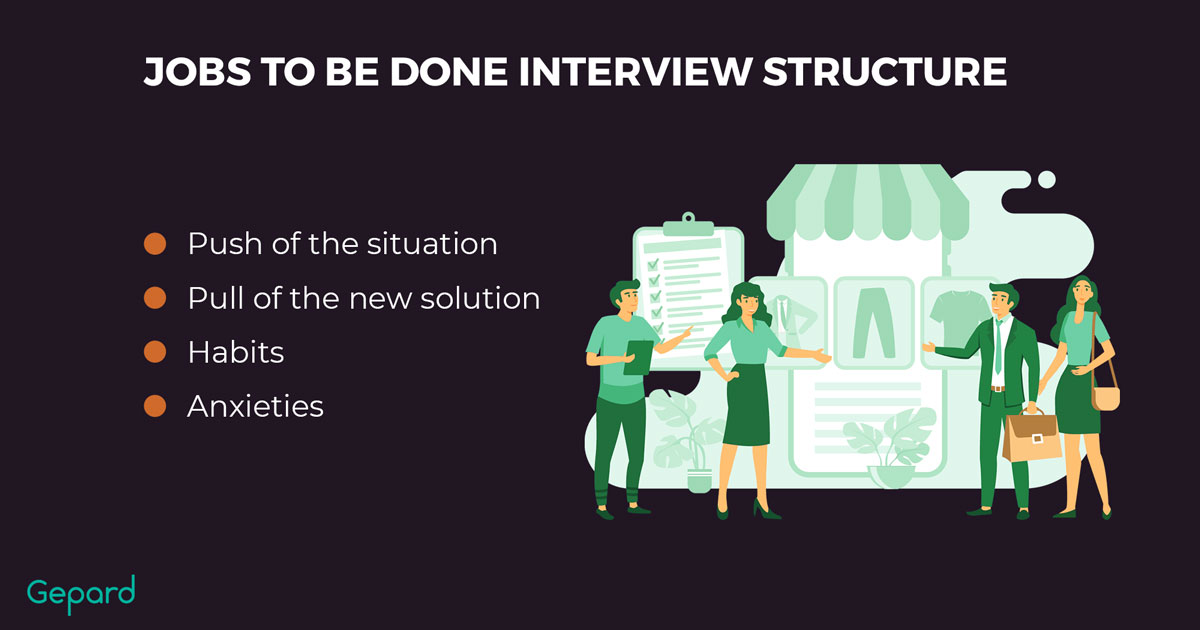Jobs To Be Done For eCommerce Customer Journey Map
Jobs to be done approach has become a surefire way to enhance eCommerce customer journey for many businesses. Based on a very simple principle of buying a benefit, a solution, comfort, and convenience, rather than a product, it helps to better understand your customers and create a one-of-a-kind buying experience. In this article, we’ll explore this customer journey approach and learn how to bring jobs to be done theory to practice. Let’s start with the jobs to be done definition.
What Is Jobs To Be Done?
Some important things about jobs to be done:
- They are tasks that a person is trying to accomplish;
- The elements of a “job” are individual for different buyer types and occasions;
- The actionable jobs to be done statements lead to designing a new product or service solutions.
What Is Jobs-As-Progress?
Jobs-as-progress is a version of JTBD approach where it’s presumed that a person searches and buys a product or service when there are inconsistencies between how things are at the moment and how a person wants them to be in the future. This eCommerce approach helps businesses to understand why customers stop buying certain products and start purchasing the other ones.
Basically, it helps to get a better idea of what stimulates a buyer to change their consumption patterns and to turn these insights into creating a better shopping experience.
What Is Jobs-As-Activities?
Jobs-as-activities model is a version of JTBD approach, interpreted by Antony Ulwick, and implies that customers want to do the activities with a product. In this case, your goal is to improve the way customers use your products or services.
How JTBD Approach Is Used In eCommerce?
Jobs to be done approach makes you raise your standards of providing a valuable eCommerce experience. It’s about going much further than offering a quality product at a reasonable price. Leveraging AI recruitment tools can help you build a skilled team capable of executing JTBD strategies effectively. You have to create a product/service or shopping experience that fits the needs of your customers and helps them achieve their goals (or jobs).
JTBD As A Part Of Customer Journeys
How Jobs-To-Be-Done Relate To Customer Journeys
Jobs to be done approach is a part of customer journey mapping, as it shows how the customer is engaging with your brand. Bringing jobs to be done theory to practice is called outcome-driven innovation and implies focusing on what the buyer tries to achieve.
Understanding what job your clients want to get done helps you improve your customer journey map, offer innovative products and services and create an excellent shopping experience.
Read more about how to improve your customer experience:
Jobs To Be Done Vs Personas
A user persona is a thoroughly examined complete characterization of people who utilize your product or service and is part of creating an eCommerce customer journey map. Usually, it consists of the age, place of residence, marital status, job, needs and goals, motivations, activities, and pain points of a user. Ideally, you create a couple of personas to make sure that your products are widely accessible to different types of users.
While personas are more focused more on hypothetical users of your product, customer jobs to be done move to what the actual users want to fulfill with your product. It makes you ask questions:
- Why do my customers use this product?
- What goal do they want to achieve using this product?
- What is the job the users are hiring this product for?
- What do my customers really want?
Both JTBD and personas approach help better understand customers and their needs. However, when talking about differences, user personas determine the users of products and services and their goals. Meanwhile, the customer jobs to be done approach identifies the opportunities for reaching these goals.
The ideal customer journey mapping combines the proper use of these two approaches that are compatible with each other.
The blended jobs to be done personas approach helps to achieve a common goal: to design a product that really helps the users do what they desire to do with this product. While the jobs to be done approach is handy at defining the final goals, the personas approach is useful in finding out users’ pain points on the way to their target.

Jobs To Be Done Interviews To Create Personas For eCommerce Customer Journey
A part of bringing jobs to be done theory to practice is conducting interviews. Jobs to be done interviews, when done properly, aim to get a full understanding of a job a customer is trying to get done with your product. Thus, when conducting interviews, you should focus not on a buying process, customer behavior, or the date of purchase, but rather on the functional jobs a buyer is trying to get done.
Finding the “switch” event is the right thing to do if you want to learn why the customers “hired” your product. It means that you should interview the responders who switched to your product or the product related to yours in the last 30 days. Talking to no less than 10 people will bring more results than interviewing only 3-4 people.
The jobs to be done interview has the following structure:
Push
Push of the situation implies asking about the circumstances that motivated users to search for a new product solution.
Pull
Pull of the new solution includes questions about the features of the new solution that motivated users to try it.
Habits
The next step is asking about the old habits of users that made them avoid switching to a new product.
Anxieties
This step involves asking users what concerns about the product they had.

Jobs To Be Done Example
Let’s imagine you are selling subscriptions to online fitness classes and recently you got new subscribers. You can use the jobs to be done interview to find out why these customers “hired” you and what new innovations you can bring to them. Here is jobs to be done example with the questions and possible answers for each part of the interview.
Q. What situation made you switch to this product? (Push)
A. I bought an annual gym membership, but I only visited a gym around 4 times ever since. I feel like my money went down the drain, especially when the Covid pandemic started and the gym got closed.
Q. What was in this online fitness subscription that made you try it? (Pull)
A. I liked the idea of a monthly subscription plan – it’s enough to try and see if I like it to prolong. Also, all the online fitness sessions are saved and available offline later – it’s really useful if I cannot attend some online classes.
Q. Which of your habits were holding you back from trying this new online fitness subscription? (Habits)
A. I really enjoy communicating with people offline and making new friends, and this is usually something you get when visiting the brick-and-mortar gyms.
Q. What anxieties/concerns did you have about the new online fitness subscription product? (Anxieties)
A. What If the online product will lack the human interaction I used to get when going to a physical gym? What if I do not have enough motivation to visit an online fitness class because I do not have the proper equipment or the “right atmosphere” at home?
This is just a short example of the customer jobs to be done interview. Apart from that, you should keep an eye on customers who “fired” you, or who switched to other similar products to understand what part of their “jobs” your product was not solving, and what innovations you can bring to change the situation and deliver on the expectations of your customers.
How To Apply A JTBD Framework To A Customer Journey In eCommerce?
1. Identify your customer’s needs to understand their real jobs.
At this stage, you have to thoroughly study your buyers to understand their needs and the problems they have to solve with your product. Learning every little detail about your customer goals is a key to a better understanding of what product innovations you can offer to help your clients get their job done. “I need a new hairdryer” isn’t a jobs to be done statement. “I need a hair drying and styling at the same time” is, on the other hand, a jobs to be done example.
2. Choose customer segments around jobs, not people.
Unlike traditional business approaches, where the customer segments are defined around people like “children”, “B2B company owners”, and “sportsmen”, the jobs to be done approach implies that your customer segments are based on the jobs/problems that have to be worked on. It could be the desire to look slim, to get to work faster without traffic jams, to be able to listen to music on the go, etc.
3. Monitor and analyze existing data.
Examine the existing data about different segments of customers who are visiting your eCommerce website (first-time visitors, repeat visitors, buyers, and potential customers who abandoned a shopping cart). Study Google analytics, look for trends or scan a session history in detail. It will help you learn what motivates your buyers or at what stage of a website journey your potential buyers lose motivation to proceed.

4. Mold your improved customer journey to the buyers’ needs.
The better relationship with a client you have at each stage of a customer journey, the more chances of a sales deal you get. Building a strong relationship with your customers, and trying to understand their psychology, pains and goals should be your ultimate goals. Use data analysis to find out what your customers care about and shape your enhanced eCommerce customer journey map to your buyers’ needs.
Read more about customer journey map for eCommerce website:
5. Build every customer journey around your buyer’s needs.
Adapt a buyer-centric approach to every customer journey and think of your eCommerce shop as an instrument that helps your customers accomplish their goals (jobs). By focusing your business around customers, you can create unparalleled shopping experiences that not only helps you convert but also facilitates long-term cooperation with your clients.
6. Add new JTBD as often as they arrive.
Use customer surveys, analytics, and JTBD interviews to recognize the new jobs to be done as soon as they appear. Use this data to add new products and services to your shop that help your clients get their job done. Keep an eye on your customers’ jobs to be done as they might change over some period of time.
7. Monitor results of improved customer journey and iterate.
Observe how your customers are interacting with your enhanced website, content, and products, find the pitfalls if any, and work on further improving your eCommerce customer journey. Constantly deepen your knowledge about your clientele and do your best to bring more value into their lives with your well-thought innovative products.
JTBD For eCommerce Customer Journey FAQ
How To Analyze Customer Journey Data?
You can analyze your customer journey eCommerce information with either a qualitative or quantitative approach. The first one involves buyer interviews, the latter includes viewing your analytics and discovering what steps the customer has made before the purchase.
Is Jobs To Be Done The Right Approach For eCommerce Customer Journeys?
Jobs to be done is a great approach for businesses that want to design product innovations. It’s one of many instruments of the Design Thinking framework that focuses on the “job” part of the analysis, rather than a customer or a product, and, in such a way, opens the door to many opportunities for creating innovative products and helping people “get their job done” better and cheaper. However, if your goal is to improve the existing product, then it might not be the most appropriate tool – User Testing could be a better fit in this case.
Product Data As A Part Of Jobs To Be Done Approach
Jobs to be done framework is a rewarding investment for businesses that want to bring real value to their clients and build a strong relationship with them throughout all the customers journeys.
In a highly digitalized eCommerce world, the real value starts with the high quality, rich, and accurate product information. For both companies that manage 1000+ SKUs and small stores, it’s essential to provide their buyers with up-to-date product content, which can be a hustle to handle.
Product information management solutions like Gepard PIM are made to simplify your work with product data on all the stages of your buyer journey. Delivering the right data to the right audience at the right time, while keeping up with dozens or hundreds of marketplaces’ requirements is something that you can delegate to a robust and simple solution such as Gepard PIM.
Ready to dominate the market with the help of top-notch product data? Request your personalized free demo now.






